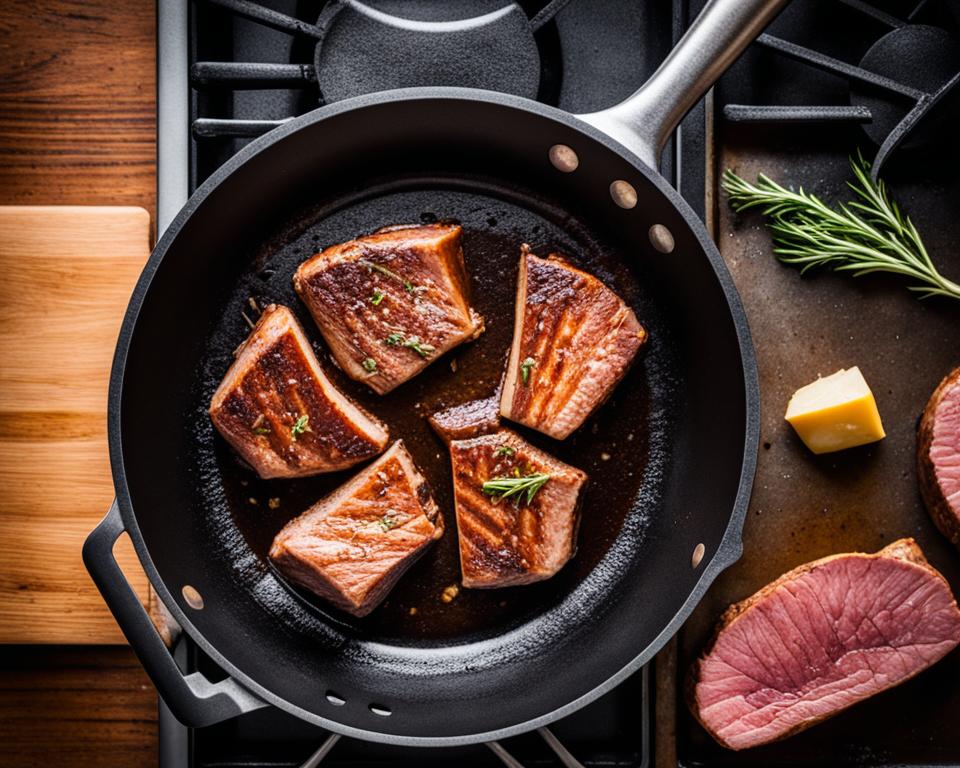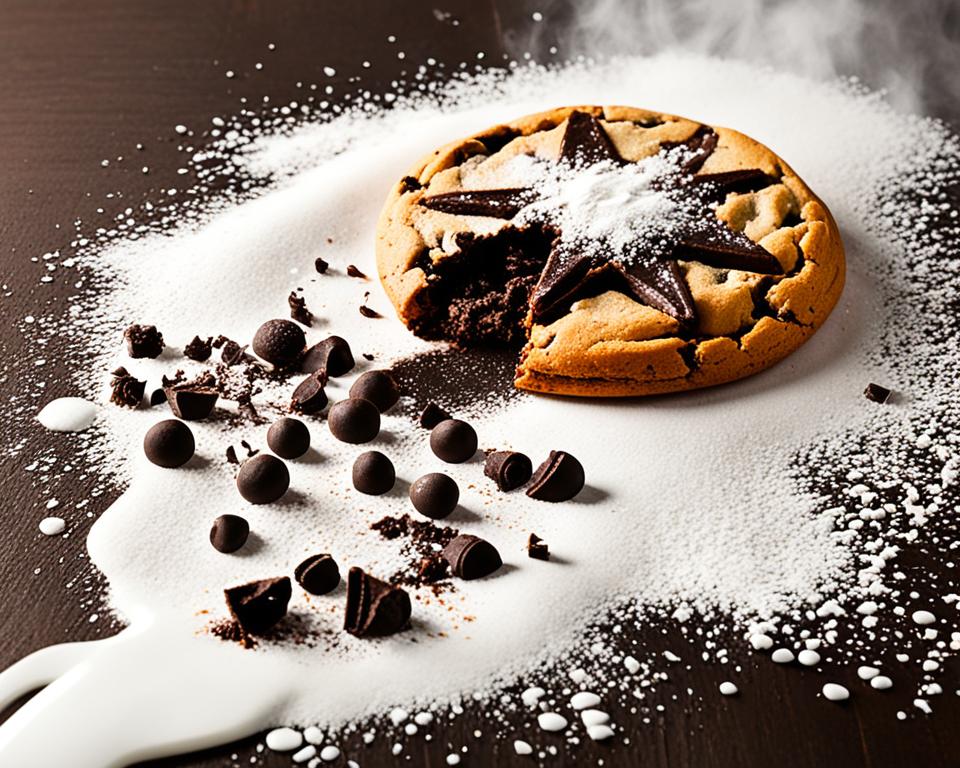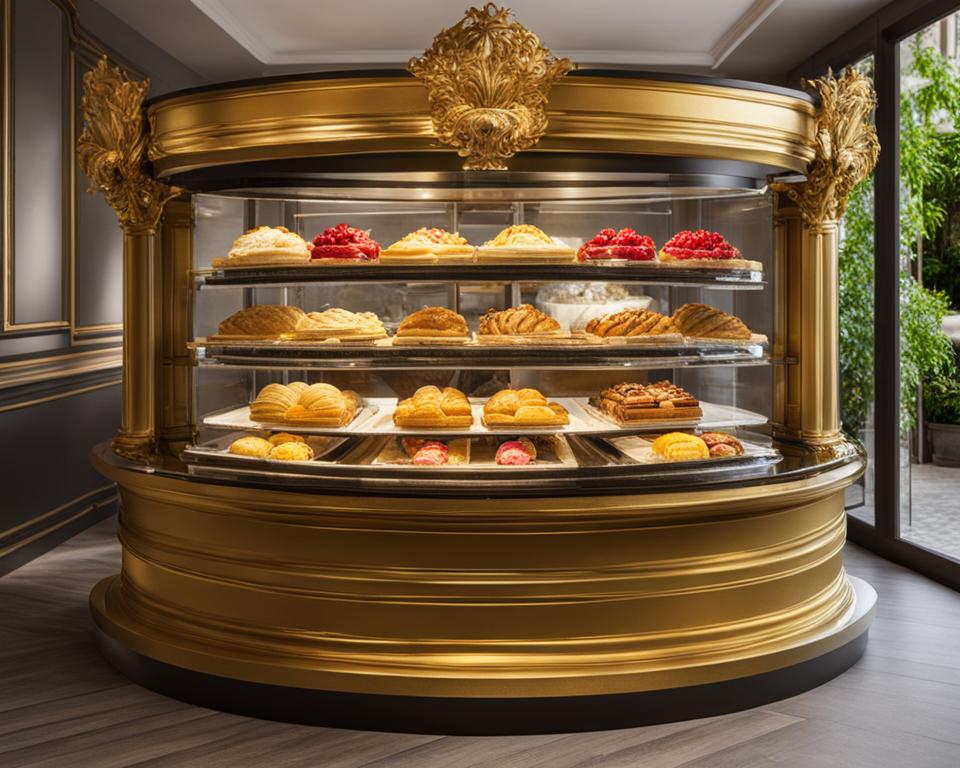Baking is a delightful and rewarding hobby, but it can be disheartening when something goes wrong with your creations. Don’t worry! We’re here to help you rescue your desserts with quick fixes for common baking mishaps.
From bread dough that refuses to rise to burnt pie crusts and cracked cheesecakes, we’ve got you covered with easy remedies and expert tips. With a little know-how, you can turn even the most unfortunate baking disasters into delicious treats.
Key Takeaways:
- Learn how to fix bread dough that won’t rise.
- Discover solutions for stuck cakes in the pan.
- Find out how to add moisture to dry cakes.
- Solve the problem of burnt pie crusts.
- Fix cracked cheesecakes with simple techniques.
How to Fix Bread Dough That Won’t Rise
If your bread dough fails to rise, there are a few potential causes. First, you need to determine if the issue is with the yeast, the heat, or a mismeasurement.
To test the yeast, create a testing sauna by placing a mug of water in the microwave. Heat the water until it steams and observe if the dough rises. If the yeast is dead, you can try to salvage it by adding live yeast or repurpose it for homemade crackers.
To prevent this issue in the future, ensure that the atmosphere is warm and moist enough, always test your yeast first, and double-check your measurements.
How to Solve the Problem of Stuck Cakes in the Pan
It can be frustrating when your cake sticks to the pan, making it difficult to remove. The best way to fix this is to let the cake cool completely, then wrap it in foil and freeze it. Once frozen, you can gently lever it out using butter knives or a spatula.
To prevent this issue, make sure to properly prep your cake pans by buttering and flouring them or using parchment paper.
| Method | Instructions |
|---|---|
| Butter and Flour | Grease the pan with butter, making sure to cover the entire surface. Then, dust the pan with flour, shaking off any excess. |
| Parchment Paper | Cut a piece of parchment paper to fit the bottom of the pan. Place it in the pan before pouring the cake batter. |
“The best way to fix this is to let the cake cool completely, then wrap it in foil and freeze it. Once frozen, you can gently lever it out using butter knives or a spatula.”
How to Moisturize Dry and Stiff Cakes
Dry and stiff cakes can be unappetizing, but there are simple methods to add moisture and improve their texture. One effective technique is to prick the cake with a toothpick and brush a simple syrup made from sugar and water over it. This helps infuse the cake with moisture, making it moist and delicious.
Pro Tip: Pricking the cake allows the syrup to penetrate deep into the cake, ensuring a moist outcome.
Additionally, sifting the flour before incorporating it into the batter can help prevent dry cakes in the first place. Sifting removes any lumps and aerates the flour, allowing it to mix more easily with the other ingredients. This results in a smoother, more consistent batter, leading to a moist and tender cake.
Tips to Moisturize Dry and Stiff Cakes:
- Prick the cake with a toothpick.
- Prepare a simple syrup by combining equal parts sugar and water.
- Brush the syrup over the cake, ensuring it is evenly distributed.
- Allow the cake to absorb the syrup for a few minutes before serving.
- Sift the flour before incorporating it into the batter.
By following these simple steps, you can salvage dry and stiff cakes, transforming them into moist and enjoyable desserts. Now, let’s explore how to fix another common baking mishap: burnt pie crusts.
How to Fix Burnt Pie Crusts
Burnt pie crusts can be disappointing, but there are ways to salvage them.
If only the edges are burnt, you can use a microplane to sand them down. This will remove the burnt bits and leave you with a perfectly edible crust.
If the whole crust is burnt, don’t worry! You have a couple of options:
- Make a new top crust: Simply roll out a new layer of dough and place it on top of the burnt crust. The fresh layer will cover up the burnt parts, giving you a delicious pie with a beautiful crust.
- Use Reddi-wip as a quick fix: Cover the burnt crust with a generous amount of Reddi-wip whipped cream. The creamy topping will not only mask the burnt flavor but also add a delightful sweetness to your pie.
To prevent burnt crusts in the first place, follow these tips:
- Use foil to cover the edges of the pie: This will protect them from excessive heat and prevent them from burning before the filling is fully cooked.
- Avoid overworking the crust: Overmixing the dough can lead to a tough crust that’s more prone to burning. Work the dough just until it comes together to maintain a tender and flaky crust.
With these simple techniques, you can rescue your pie crusts and enjoy delicious pies every time.
How to Fix Cracked Cheesecakes
Cheesecakes are a delightful dessert, but it can be disappointing when cracks appear on the surface. However, there are simple techniques to fix these cracks and ensure your cheesecakes look as delicious as they taste.
To begin, it’s important to cool the cheesecake completely before attempting to fix the cracks. Place it in the refrigerator for at least a few hours or overnight, allowing it to set and firm up.
Once the cheesecake is thoroughly chilled, you can start the repair process. Prepare a bowl of warm water and a metal spatula. Dip the spatula into the warm water to heat it up, then carefully glide it over the cracks in the cheesecake surface. The warmth from the spatula will help to smooth out the cracks and make them less noticeable.
If the cracks are more significant, you can use a technique called “glazing.” Prepare a simple glaze by mixing powdered sugar with a small amount of water or lemon juice. Drizzle the glaze over the cracked areas, allowing it to flow into the cracks and fill them. The glaze will set as it dries, sealing the cracks and leaving a smooth surface.
To prevent cracks from occurring in the first place, there are a couple of preventive measures you can take. One effective method is to use a water bath while baking the cheesecake. This involves placing the cheesecake pan inside a larger pan filled with hot water during the baking process. The water bath provides a moist atmosphere in the oven, reducing the chances of the cheesecake cracking.
Another crucial tip is to avoid opening the oven door while the cheesecake is baking. Sudden changes in temperature can cause the surface to crack. Instead, rely on the recommended baking time and use a timer to know when your cheesecake is perfectly cooked.
To summarize:
- Cool the cheesecake completely in the refrigerator.
- Use a warm metal spatula to smooth out cracks on the chilled cheesecake.
- For more significant cracks, drizzle a powdered sugar glaze to seal and fill them.
- During baking, use a water bath and avoid opening the oven door to prevent cracks from forming.
| Issue | Solution |
|---|---|
| Cracks on the cheesecake surface | Cool the cheesecake completely, use a warm metal spatula to smooth out cracks, glaze with a powdered sugar mixture if necessary, and prevent cracks by using a water bath and avoiding oven door openings. |
By following these simple techniques, you can salvage cracked cheesecakes and present a flawless dessert that will impress your guests. Remember, even if cracks do occur, they do not affect the taste, and with a little care, you can transform them into a beautiful masterpiece.
Tips for Perfect Pastry
Pastry can be tricky, but with the right tips, you can achieve perfect results. Whether you’re making a pie crust or working with puff pastry, here are some expert suggestions to help you create delicious and flaky pastry every time.
Avoiding Soggy Pie Crust
One common challenge when making pies is achieving a crispy crust without it becoming soggy from the filling. To avoid this, reduce the moisture in the filling by cooking it down or thickening it with cornstarch. Additionally, you can reinforce the pastry for larger pies by brushing it with beaten egg white before adding the filling. This creates a barrier that prevents the filling from seeping into the crust.
Preventing Shrinkage
Have you ever experienced your pastry shrinking from the pan during baking? To prevent this, it’s important to be patient during the mixing process. Overworking the dough can activate the gluten, causing the pastry to shrink when baked. Also, ensure that your oven is at the correct temperature before putting the pastry in to bake.
Achieving Flaky Texture
If your pastry tends to crumble or become dry, there are a few tricks to overcome this. Start by using cold water when making the dough and adding it gradually. Avoid using too much flour when rolling out the pastry, as excess flour can make the dough tough and prone to cracking. Remember, the goal is to keep the fat in the pastry chilled until it melts during baking, creating flaky layers.
Working with Puff Pastry
Puff pastry requires special care to prevent it from collapsing during baking. When working with puff pastry, always keep it chilled until you’re ready to use it. Thaw it in the refrigerator, not at room temperature, to maintain its texture. Additionally, handle the pastry gently and avoid pressing down on it too firmly, as this can deflate the layers. Following these techniques will help you achieve beautifully puffed and golden pastry.
With these tips in mind, you can confidently create perfect pastry for all your baking needs. Whether you’re making pies, tarts, or delicate pastries, applying these expert recommendations will help you achieve delicious and impressive results.
Common Cake and Custard Problems Solved
Cakes and custards can sometimes encounter problems during the baking process. Luckily, there are simple solutions to these mishaps that can help you salvage your desserts. By addressing common issues like curdled cake batter, crumbly pastry, crystallized caramel, over-whipped cream, and broken Victoria sponge, you can rescue your baking creations and delight your taste buds.
1. Curdled Cake Batter
If your cake batter appears curdled, there’s no need to panic. To fix this issue, warm the mixture slightly by placing it over a gentle heat source. Then, vigorously beat the batter again to emulsify the ingredients and restore its smooth consistency.
2. Crumbly Pastry
Crumbly pastry can be a frustrating problem, resulting in a texture that is less than ideal. To prevent this issue, ensure that you chill the pastry dough properly before rolling it out. Additionally, make sure to add enough liquid when preparing the dough, as the moisture helps bind the ingredients together and improve the texture.
3. Crystallized Caramel
If you find that your caramel has crystallized, don’t worry. There are ways to rescue it. To dissolve the crystals, you can gently reheat the caramel and stir it until the sugar dissolves completely. Alternatively, you can add a small amount of vinegar or lemon juice to the mix, which helps prevent the sugar from crystallizing.
4. Over-Whipped Cream
If you’ve accidentally over-whipped your cream and it has become too stiff, don’t despair. To salvage it, simply add a splash of milk or a small amount of vanilla extract to the over-whipped cream and gently fold it in. This will help to soften the cream and restore its smooth and creamy consistency.
5. Broken Victoria Sponge
A broken Victoria sponge can be disappointing, but it’s not the end of the world. To fix this issue, use the icing between the broken pieces as a glue to hold them together. By gently pressing the broken sections together, you can mend the cake and still enjoy a delicious slice.
These tips and techniques will help you overcome common cake and custard problems and ensure that your baking endeavors are successful. Remember, even the most experienced bakers encounter mishaps from time to time, but with a little know-how and creativity, you can turn these challenges into triumphs.

How to Rescue Overcooked Pasta and Rice
Even the most skilled chefs can sometimes end up with overcooked pasta and rice. But don’t worry, there’s still hope for rescuing these culinary mishaps. By following a simple technique, you can salvage overcooked pasta and rice and transform them into delicious dishes.
To rescue overcooked pasta and rice, start by draining them thoroughly to remove the excess moisture. Then, heat a pan with a generous amount of oil and add the overcooked pasta or rice. Fry them over medium heat, stirring occasionally, until the excess moisture evaporates and the pasta or rice becomes slightly crispy and golden brown. This process helps to improve the texture and flavor of the overcooked grains.
To prevent overcooking in the first place, it’s essential to follow the recommended cooking times provided on the packaging. Additionally, using a kitchen timer can help you keep track of the cooking process and avoid leaving the pasta or rice on the heat for too long.
Tip: Don’t be afraid to get creative with your overcooked pasta and rice. You can repurpose them in various recipes such as stir-fries, casseroles, or soups. Think of them as a blank canvas to experiment with different flavors and ingredients!
Rescued Pasta and Rice Recipe
Here’s a simple and flavorful recipe to make the most of your rescued overcooked pasta or rice:
- Ingredients:
- 1 cup of overcooked pasta or rice
- 1 tablespoon olive oil
- 1 clove garlic, minced
- 1/2 cup diced vegetables (e.g., bell peppers, zucchini, carrots)
- Salt and pepper to taste
- Grated Parmesan cheese for garnish
- In a pan, heat the olive oil over medium heat.
- Add the minced garlic and diced vegetables and sauté until they become tender.
- Add the overcooked pasta or rice and stir-fry for a few minutes, allowing them to absorb the flavors.
- Season with salt and pepper according to your taste preferences.
- Remove from heat and garnish with grated Parmesan cheese.
- Serve hot and enjoy your rescued pasta or rice dish!
With this simple technique and recipe, you can turn overcooked pasta and rice into a culinary triumph. Don’t let a minor cooking mishap spoil your meal. Instead, rescue and transform it into something delicious!
How to Brown Meat Properly
If your meat won’t brown, it may be due to excess moisture or an insufficiently hot pan. Patting the meat dry and using hot oil can help achieve a browned exterior. To prevent this issue, make sure the meat is not too wet and the pan is adequately heated before browning.
When browning meat, ensuring a hot and dry surface is essential. Excess moisture can hinder the browning process and result in a lackluster appearance. Before cooking, gently pat the meat dry with paper towels or a clean kitchen cloth. This will remove any moisture on the surface, allowing for better browning.
Next, heat a pan over medium-high heat until it is hot but not smoking. Adding the meat to a cold or insufficiently heated pan can prevent proper browning. To test if the pan is hot enough, you can sprinkle a few drops of water onto the surface. If the water immediately sizzles and evaporates, the pan is ready.
Once the pan is hot, add a small amount of oil with a high smoke point, such as canola or vegetable oil. Swirl the oil to evenly coat the pan. Then, carefully place the meat in the hot pan, ensuring that each piece has enough space for proper browning. Overcrowding the pan can lead to steaming instead of browning.
Allow the meat to cook undisturbed for a few minutes on each side. This will allow a flavorful crust to form. Avoid moving or flipping the meat too frequently, as this can prevent the development of a crispy exterior. Use tongs or a spatula to flip the meat once it has developed a deep brown color on one side.
Remember, browning meat not only adds visual appeal but also enhances flavor by creating rich caramelization. With these tips, you can achieve beautifully browned meat that is both visually appealing and delicious.

Tips for Browning Meat:
- Pat the meat dry before cooking to remove excess moisture.
- Ensure the pan is heated adequately before adding the meat.
- Use a high smoke point oil to coat the pan.
- Cook the meat undisturbed for a few minutes on each side to allow a crust to form.
- Avoid overcrowding the pan to promote browning instead of steaming.
Common Mistakes when Browning Meat:
While browning meat, it’s important to avoid these common mistakes:
- Using a pan that is not hot enough.
- Adding wet meat to the pan.
- Moving or flipping the meat frequently.
- Overcrowding the pan.
By following these guidelines and avoiding common pitfalls, you’ll be able to brown meat to perfection and add an appetizing color to your dishes.
Conclusion
Baking mishaps happen to the best of us, but don’t despair! With the right tips and quick fixes, you can rescue your desserts and turn them into delightful creations. Whether you’re dealing with bread dough that won’t rise, cracked cheesecakes, or burnt pie crusts, there are solutions for common baking problems.
By following expert tips and remedies, you’ll be equipped to tackle any future baking challenge. Remember to double-check your measurements, test your yeast, and properly prepare your pans to prevent mishaps from happening again. With a little know-how and confidence, you’ll be able to overcome any baking disaster.
So, don’t get discouraged when things don’t go as planned in the kitchen. Arm yourself with the knowledge and techniques shared in this article, and you’ll be well on your way to becoming a baking pro. Get ready to impress your family and friends with your delicious and beautifully executed desserts. Happy baking!
FAQ
How can I fix bread dough that won’t rise?
To fix bread dough that won’t rise, test the yeast first, ensure the atmosphere is warm and moist enough, and double-check your measurements.
What can I do to remove a stuck cake from the pan?
To remove a stuck cake from the pan, let it cool completely, wrap it in foil and freeze it, then gently lever it out using butter knives or a spatula.
How can I moisturize dry and stiff cakes?
Prick the cake with a toothpick and brush a simple syrup made from sugar and water over it. Sifting the flour can also help prevent dry cakes.
Can I fix a burnt pie crust?
Yes, you can fix a burnt pie crust. If only the edges are burnt, you can use a microplane to sand them down. If the whole crust is burnt, you can make a new top crust or use Reddi-wip as a quick fix.
Is there a way to fix cracked cheesecakes?
Yes, you can fix cracked cheesecakes. Cool the cheesecake completely, then smooth out the cracks using warm water and a metal spatula. To prevent cracks, use a water bath while baking and avoid opening the oven door.
What are some tips for perfect pastry?
To achieve perfect pastry, reduce moisture in the filling for a soggy crust, be patient during mixing to prevent shrinking from the pan, and follow proper techniques with puff pastry to prevent collapsing.
How can I solve common cake and custard problems?
Curdled cake batter can be fixed by warming and beating it again, crumbly pastry can be prevented by chilling the dough and adding enough liquid, crystallized caramel can be fixed by dissolving the crystals or adding vinegar/lemon juice, and over-whipped cream can be salvaged by adding milk or vanilla extract.
Can overcooked pasta and rice be salvaged?
Yes, overcooked pasta and rice can be salvaged. Drain them and fry them in oil to remove excess moisture and improve the texture and flavor.
How can I brown meat properly?
To brown meat properly, pat it dry and use hot oil. This helps achieve a browned exterior. Also, ensure the meat is not too wet and the pan is adequately heated before browning.
What can I do to rescue my baking creations?
By following the expert tips and remedies mentioned, you can rescue your baking creations. Double-check your measurements, test your yeast, and properly prepare your pans to prevent future mishaps.




